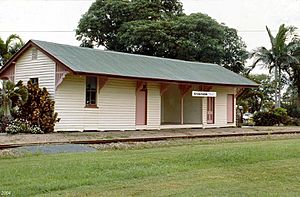Mirani railway station, Queensland facts for kids
Quick facts for kids Mirani railway station |
|
|---|---|

Mirani railway station, 2004
|
|
| Location | Victoria Street, Mirani, Mackay Region, Queensland, Australia |
| Design period | 1870s - 1890s (late 19th century) |
| Built | 1885 - 1913 |
| Architectural style(s) | Classicism |
| Official name: Mirani Railway Station Building, Hamilton Railway Station | |
| Type | state heritage (built) |
| Designated | 7 July 2005 |
| Reference no. | 600984 |
| Significant period | 1880s-1970s (historical) |
| Significant components | railway station, views to |
| Lua error in Module:Location_map at line 420: attempt to index field 'wikibase' (a nil value). | |
The Mirani railway station is an old train station in Mirani, Queensland, Australia. It's a special heritage-listed building, meaning it's protected because of its history. This station was part of the Pioneer Valley railway line and was built between 1885 and 1913. It was also known as Hamilton railway station for a time.
Contents
Station History
The Mirani railway station first opened on 10 August 1885. It was part of the new Mackay Railway system. This railway helped connect the growing towns and farms in the area.
Early Settlement and Sugar
In the 1860s, John Mackay explored this area, which was later named the Pioneer Valley. Soon, settlers arrived to start cattle farms. The area where Mirani is now was once part of a large cattle property called Hamilton. The town's name was changed from Hamilton to Mirani to avoid confusion with another Hamilton in Brisbane.
Sugar cane became a very important crop in this region. Sugar cane is heavy and needs to be processed quickly after it's picked. In the 1800s, trains were the best way to move it fast. So, many sugar-growing areas built special railway lines.
Building the Railway
People started asking for a local railway network in the late 1870s. Sugar cane farmers wanted to be able to choose which sugar mill crushed their cane. A government-run railway would give them more freedom.
The plan for the Pioneer Valley line was approved in October 1882. Construction began in late 1883. The first part of the line, from Mackay to Mirani, opened on 10 August 1885. This railway helped Mackay grow as a major sugar center.
Mirani as a Hub
The railway station quickly became a key part of Mirani. From 1888 to 1924, the station even handled all the town's mail! Harry Wesche, a worker at the station around 1915, planted mango trees in the station yard. Some of these trees are still there today.
For a while, Mirani was the end of the railway line. But farmers wanted the line to go further west to open up more land for sugar cane. However, the Pioneer River was a big obstacle.
Extending the Line
In 1897, the railway line was finally extended over the Pioneer River at Mirani. A large bridge with steel spans was built. This two-kilometer extension to Mirani West opened on 11 December 1897. Later, the line was extended even further west to Pinnacle, opening on 7 July 1902.
The Pioneer Valley line was very important for Mirani. It helped the town become a key center in the Mackay region. It also helped the sugar industry grow a lot, making it easier to transport sugar cane from more distant farms.
Changes and Closure
Over the years, the Mirani Railway Station building was changed and updated. For example, in 1913, parts of the building were remodeled. By 1960, the station included the main building, a lamp room, living quarters, and sheds for loading goods.
The Mackay Railway, including the section through Mirani, officially closed on 19 December 1977, after being damaged by floods. In 1988, the Mirani Shire Council received money to turn the old station building into a museum. This allowed the building to stay in its original spot. The railway line between Marian and Finch Hatton, which included Mirani, closed completely on 2 October 1990. Today, many old railway lines in sugar areas are disappearing as trucks take over more of the transport.
The Mackay Regional Council now looks after the former station building, which serves as a reminder of the area's railway history.
Station Description
The Mirani Railway Station building is made of timber and sits on low wooden stumps. It has a pointed roof covered with corrugated iron. There are wooden vents high up on the east and west sides. The roof extends out on both the north and south sides, providing shade.
The building has fancy wooden decorations, called spandrels, along the northern and southern sides of the shelter area. These look similar to those at the Finch Hatton railway station further down the line.
Inside, there were once office areas, a ladies' room, and ticket windows facing the shelter area. You can still see the station name boards along the old railway line. About 60 meters east of the main building, there's also a small timber shed that was used for trolleys.
Heritage Importance
The former Mirani railway station was added to the Queensland Heritage Register on 7 July 2005. This means it's recognized as an important historical site.
Historical Significance
The Mirani railway station building is important because it shows how Queensland's history developed. It's a good example of a country branch line station that played a big role in the sugar industry. It also shows how railways were once vital for transporting goods, and how that changed over time. The building is one of the oldest surviving railway buildings on the Mackay Railway.
Unique Features
The Mirani Railway Station building is a great example of a timber railway building found on country branch lines. It had an office, a shelter area with shade, and ticket windows. Its decorative wooden spandrels are a special feature, similar to those at the Finch Hatton Railway Station.

